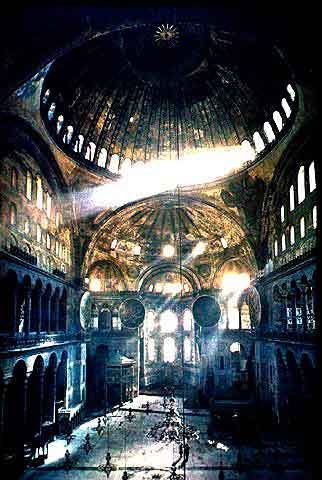
CHURCHES: ANTIQUITY
Until the fourth century CE, Christianity was not a legal religion. Even in parts of the Roman Empire where it was not actively persecuted, it was rarely trusted or accepted. Because of this, there is little evidence for public architecture in Christianity. The first Christians most likely met in private homes, owned by the wealthier members of the community.
At some point in the third century, as Christianity gained public confidence in some cities, it seems that some of these private homes were actually converted into sanctuaries for Christians: buildings dedicated as Christian worship space. These "house-churches" had the advantage of remaining publicly invisible (from the outside, they still looked like residential homes), while providing some Christian communities with a greater sense of stability.
One of our best examples of one such house church is in the city of Dura Europos on the Persian border of the Roman Empire. The city was destroyed in 256 CE, leaving us well-preserved examples of various pagan, Jewish, and Christian places of worship. The image below is of a reconstruction of the Christian baptistery (room dedicated to the initiation ritual of baptism):

The partially reconstructed image on the right probably shows the women who witnessed Jesus' crucifixion arriving at his tomb (here portrayed as a stately Roman sarcophagus) to find that he has been resurrected.
Once Constantine the Great legalized Christianity (in 313 CE), Christians at last began crafting a public "face" through architecture. Constantine endowed massive public buildings (called basilicas, literally "royal [public] houses") for use by Christians. The tradition of Roman emperors endowing massive and impressive public churches continued, exemplified by the sixth-century church of "holy wisdom" (Hagia Sophia, in Greek) in the eastern capital city of Constantinople:

When the emperor Justinian completed this massive church structure, he is rumored to have exclaimed, "I have outdone you, Solomon!" referring to Solomon as the builder of the first Temple in Jerusalem. (When the ottoman Turks conquered Constantinople in 1453, they converted the massive church into a mosque--thus, the four minarets, or mosque towers, that surround the building today).
The interior of the Hagia Sophia was considered something close to a miracle:

The massive dome rose incredibly high (especially considering the constraints of sixth-century architectural engineering), and inspired a sense of spiritual-material convergence: the light entering through the windows at the base of the dome was like a glimpse of divine energy coming into the sacred space of the church.